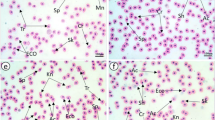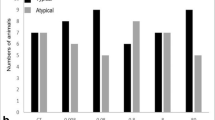Abstract
Light-sticks shine resulting from a chemiluminescent reaction between two components kept separate by a glass ampoule. Light-stick baits are discarded in the ocean after being used in longline fishing. The traditional Brazilian community of Costa dos Coqueiros, Brazil, uses the discarded light-sticks chemical contents found on beaches as medicine for rheumatism and mycoses. This study assessed the effects that light-sticks (chemical contents) have on Pachygrapsus transversus and Litopennaeus vanammei. Assays of metabolic changes involved rates of ammonia excretion and oxygen consumption. The EC50–60 min to juveniles and adults P. transversus were 0.0004% and 0.0046%, respectively; and L. vanammei revealed a susceptible species: EC50–60 min of 0.0006% for oxygen uptake and 0.0072% for ammonia excretion, and also was observed a hormesis effect in the ammonia excretion. Light-stick contents could promote significant metabolic changes in rocky crabs and gray shrimp. Educational actions are needed that make the population aware of and avoid the dangerous misuse of the light-sticks.
Graphic Abstract




Similar content being viewed by others
References
Abele LG (1976) Comparative species composition and relative abundance of decapod crustaceans in marine habitats of Panama. Mar Biol 38:263–278
Abele LG, Campanella PJ, Salmon M (1986) Natural history and social organization of the semiterrestrial grapsid crab Pachygrapsus tranversus (Gibbes). Exp Mar Biol Ecol 104:153–170
Albers PH (1994) Petroleum and individual polycyclic aromatic hydrocarbons. In: Hoffman DJ, Rattner BA, Burton GA Jr, Cairns J Jr (eds) Handbook of ecotoxicology. CRC Press, Boca Raton
Amand STL, Gagnon R, Packard TT, Savenkoff C (1999) Effects of inorganic mercury on the respiration and the swimming activity of shrimp larvae, Pandalus borealis. Comp Biochem Physiol Pharmacol Toxicol Endocrinol 122(1):33–43
Amorim AF, Arfelli CA (1984) Estudo biológico pesqueiro do espadarte, Xiphias gladius Linnaeus, 1758, no Sudeste e Sul do Brasil, (1971 a 1981). Bolm Inst Pesca São Paulo 11:35–62
Amorim AF, Arfelli CA, Fagundes L (1998) Pelagic elasmobranchs caught by longliners off southern Brazil during 1974–97: an overview. Mar Freshw Res 49: 621–632
Araújo MMS, Nascimento IA (1999) Testes ecotoxicológicos marinhos: análise de sensibilidade. Ecotoxicol Environ Restor 2(1):41–47
Araújo MMS, Menezes Filho A, Nascimento IA, Pereira PAP (2015) Light-sticks content toxicity: effects of the water soluble fraction on the oyster embryonic development. Chemosphere (Oxford) 139:73–80
Axelrod D, Burns K, Davis D, von Larebeke N (2004) ‘Hormesis’—an inappropriate extrapolation from the specific to the universal. Int J Occup Environ Health 10(3):335–339. https://doi.org/10.1179/oeh.2004.10.3.335.hdl:1854/LU-867581
Barbieri E (2007) Use of oxygen consumption and ammonium excretion to evaluate the sublethal toxicity of Cadmium and Zinc on Litopenaeus schmitti (Burkenroad, 1936, Crustacea). Water Environ Res 79(6):641–646
Barbieri E (2008) Effects of surfactants DSS and LAS-C12 on pink shrimp (Farfantepenaeus paulensis, Pérez-Farfante). J Braz Soc Ecotoxicol 3:35–40
Barbieri E (2009) Effects of zinc and cadmium on oxygen consumption and ammonium excretion in pink shrimp (Farfantepenaeus paulensis, Pérez-Farfante, 1967, Crustacea). Ecotoxicology 18(3):312–318
Barbieri E, Doi SA (2012) Acute toxicity of ammonia on juvenile Cobia (Rachycentron canadum, Linnaeus, 1766) according to the salinity. Aquac Int 20(2):373–382
Barbieri E, Oliveira IR, Serralheiro PAC (2002) The use of metabolism to evaluate the toxicity of dodecylbenzene sodium sulfonate (LAS-C12) on the Mugil platanus according to the temperature and salinity. J Exp Mar Biol Ecol 277:109–112
Barbieri E, Passos AE, Garcia CAB (2005) Use of metabolism to evaluate the subletal toxicity of mercury on Farfantepanaeus brasiliensis larvae. J Shellfish Res 24(4):608–611
Borak J, Sirianni G (2005) Hormesis: implications for cancer risk assessment. Dose-Response 3(3):dose-response
Buesa RJ (1979) Oxygen consumption of two tropical spiny lobsters, Panulirus argus (Latreille) and P guttatus (Latreille) (Decapoda, Palinuridae). Crustaceana 36(1):99–107
Burke M (2009) The start of something big. Environ Sci Technol 15:977
Cassola RS, Castro EBV, Rodrigues JRCE, Reinecke W, Breyer EB (2004) O impacto da carcinicultura nas áreas de proteção ambiental federais costeiras do nordeste brasileiro In: Anais do IV Congresso Brasileiro de Unidades de Conservação, 1:406–416. Fundação O Boticário de Proteção à Natureza, Rede Nacional Pró Unidades de Conservação, Curitiba, PR
Cesar-Ribeiro C, Palanch-Hans MF (2010) Chronic toxicity test with sea urchin Echinometra lucunter and Lytechinus variegatus (Echinodermata: Echinoidea), exposed to light-stick—flag paternoster used for fishing surface longline. Braz J Oceanogr 58:71–75
Cesar-Ribeiro C, Costi-Rosa H, Rocha DO, Baldini dos Reis CG, Prado TS, Muniz DHC, Carrasco R, Silva FM, Martinelli-Filho JE, Palanch-Hans MF (2017) Light-stick: a problem of marine pollution in Brazil. Mar Pollut Bull 117(1–2):118–123
Clark RB (1986) Consequence of oil pollution. Mar Pollut 4:48–66
Coleman WF (2009) Molecular models of compounds in light-sticks. J Chem Educ 86(1):128
Daam MA, Van Den Brink PJ (2010) Implications of differences between temperate and tropical freshwater ecosystems for the ecological risk assessment of pesticides. Ecotoxicology 19:24–37
Damato M, Barbieri E (2011) Determinação da toxicidade aguda de cloreto de amônia para uma espécie de peixe (Hyphessobrycon callistus) indicadora regional. Mundo Saúde 35(4):42–49
De Figueredo LP, Nilin J, da Silva AQ, Loureiro S, Costa-Lotufo LV (2016) Development of a short-term chronic toxicity test with a tropical mysid. Mar Pollut Bull 106(1–2):104–108
De Oliveira TF, Da Silva ALM, De Moura RA, Bagattini R, De Oliveira AAF, De Medeiros MHG, de Melo Loureiro AP (2014) Luminescent threat: toxicity of light stick attractors used in pelagic fishery. Sci Rep 4:5359
Echevarréa G, Zarauz N, López-Ruiz J (1993) Study of nitrogen excretion in the gilthead seabream (Sparus aurata L.): influence of nutritional state. Comp Biochem Physiol Part A Physiol 105(1):17–19
Fardy M, Yang P (2008) Lilliputian light sticks. Nature 451:408–409
Hazin HG et al (2005) Effect of light-sticks and electralume attractors on surface-longline catches of swordfish (Xiphias gladius, Linnaeus, 1959) in the southwest equatorial. Atl Fish Res 72:271–277
Hill MK (2004) Understanding environmental pollution. The Journal of Environmental Education. Cambridge, pp 59–60
Iavicoli I, Leso V, Fontana L, Calabrese EJ (2018) Nanoparticle exposure and hormetic dose-responses: an update. Int J Mol Sci 19:E805. https://doi.org/10.3390/ijms19030805
Ivar do Sul JA, Rodrigues O, Santos IR, Fillmann G, Matthiensen A (2009) Skin irritation and histopathologic alterations in rats exposed to light-stick contents, UV radiation, and seawater. Ecotoxicol Environ Saf 72:2020–2024
Jonker MTO, Hoenderboom M, Koelmans AA (2004) Effects of sedimentary sootlike materials on bioaccumulation and sorption of polychlorinated biphenyls. Environ Toxicol Chem 23(11):2563–2570
Kaiser J (2003) Sipping from a poisoned chalice. Science 302(5644):376–379. https://doi.org/10.1126/science.302.5644.376
Kennish JM (1997) Practical handbook of estuarine and marine pollution. CRC Press, Boca Raton, p 524
Kleinsasser NH, Wallner BC, Kastenbauer ER, Muenzenrieder RK, Harréus UA (2000a) Comparing the genotoxic sensitivities of human peripheral blood lymphocytes and mucosa cells of the upper aerodigestive tract using the Comet assay. Mutat Res Genet Toxicol Environ Mutagen 467(1):21–30
Kleinsasser NH, Kastenbauer ER, Weissacher H, Muenzenrieder RK, Harréus UA (2000b) Phthalates demonstrate genotoxicity on human mucosa of the upper aerodigestive tract. Environ Mol Mutagen 35(1):9–12
Koroleff F (1983) Determination of ammonia. In: Grasshoff K, Ehrhardt A, Kremling K (eds) Methods of seawater analysis, 2nd edn. Verlag Chemie, Weinheim, pp 150–157
Krull M, Barros F (2012) Key issues in aquatic ecotoxicology in Brazil: a critical review. J Braz Soc Ecotoxicol 7:57–66
Lee WY, Nicol JAC (1978) Individual and combined toxicity of some petroleum aromatics to the marine amphipod Elasmopus pectenicrus. Mar Biol Berl 48:215–222
Lemaire P, Sturve J, Forlin L, Livingstone DR (1996) Studies on aromatic hydrocarbon quinone metabolism and DT-diaphorase function in liver of fish species. Mar Environ Res 2(1–4):317–321
Leung KMY, Chu JCW, Wu RSS (1999) Effects of body weight, water temperature and ration size on ammonia excretion by the areolated grouper (Epinephelus areolatus) and mangrove snapper (Lutjanus argentimaculatus). Aquaculture 170(3–4):215–227
Lin CY, Chen JC (2003) Acute toxicity of nitrite on Litopenaeus vannamei (Boone) juveniles at different salinity levels. Aquaculture 224(1–4):193–201
Mattson MP (2007) Hormesis defined. Ageing Res Rev 7(1):1–7. https://doi.org/10.1016/j.arr.2007.08.007
Moraes BCR, Pfeiffer CW, Guimarães JR, Borges ALN, Campos AN (1999) Efeito de sedimentos contaminados sobre a excreção de nitrogênio do camarão Penaeus paulensis. Braz Arch Biol Technol 42(4):42
Neilson AH (1998) PAHs and related compounds: biology. In: Neilson AH (ed) The handbook of environmental chemistry: volume 3: anthropogenic compounds. JSpringer, p 386
Phan VN, Gomes V, Morais DM, Passos MJACR (1993) Estudo bioenergético de animais marinhos costeiros I Paralonchurus brasiliensis (Perciformes, Sciaenidae). Publ Esp Inst Oceanogr S Paulo 10:199–215
Pinho GLL, Ihara PM, Fillmann G (2009) Does light-stick content pose any threat to marine organisms? Environ Toxicol Pharmacol 27:155–157
Selkirk JK (1980) Modifiers of chemical carcinogenesis. In: Slaga TJ (ed) Carcinogenesis: a comprehensive survey, vol 5. Raven Press, New York, pp 3–14
Sullivan KF, Atlas EL, Giam CS (1982) Adsorption of phthalic acid ester from seawater. Environ Sci Technol 16:428–432
Thompson RB, Mcbee SES (1988) Peroxyoxalate chemiluminescence in microemulsions. Langmuir 4(1):106–110
Thurston RV, Russo RC, Vinogradov GA (1981) Ammonia toxicity to fishes. Effect of pH on the toxicity of the un-ionized ammonia species. Environ Sci Technol 15:807–840
USEPA (2010) Priority pollutants. http://water.epa.gov/scitech/swguidance/methods/pollutants.cfm
Verriopoulos G, Moraitou-Apostolopoulou M, Xatzispirou A (1986) Evaluation of metabolic responses of Artemia salina to oil and oil dispersant as a potential indicator of toxicant stress. Bull Environ Contam Toxicol 36:444–451
Acknowledgements
The authors wish to thank the Global Garbage NGO for their financial support in the scientific hike, particularly Fabiano P. Barreto and the “Capitães de Areia” for their guidance.
Author information
Authors and Affiliations
Corresponding author
Additional information
Publisher’s Note
Springer Nature remains neutral with regard to jurisdictional claims in published maps and institutional affiliations.
Rights and permissions
About this article
Cite this article
Cesar-Ribeiro, C. Chemical Contents of Disposed Light Sticks Affect the Physiology of Rocky Crab Pachygrapsus transversus and Gray Shrimps Litopennaeus vanammei. Bull Environ Contam Toxicol 107, 370–377 (2021). https://doi.org/10.1007/s00128-021-03321-5
Received:
Accepted:
Published:
Issue Date:
DOI: https://doi.org/10.1007/s00128-021-03321-5




